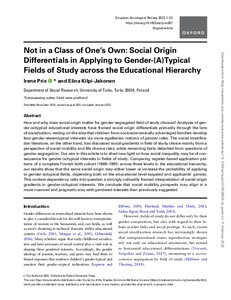Not in a Class of One’s Own: Social Origin Differentials in Applying to Gender-(A)Typical Fields of Study across the Educational Hierarchy
Kilpi-Jakonen Elina; Prix Irene
https://urn.fi/URN:NBN:fi-fe2022021619380
Tiivistelmä
How and why does social origin matter for gender-segregated field of study choices? Analyses of gender-(a)typical educational interests have framed social origin differentials primarily through the lens of socialization, resting on the idea that children from socioeconomically advantaged families develop less gender-stereotypical interests via more egalitarian notions of gender roles. The social stratification literature, on the other hand, has discussed social gradients in field of study choice mainly from a perspective of social mobility and life chance risks, while remaining fairly detached from questions of gender segregation. Our aim in this article is to shed new light on how social inequality may be of consequence for gender-(a)typical interests in fields of study. Comparing register-based application patterns of a complete Finnish birth cohort (1989–1991) across three levels in the educational hierarchy, our results show that the same social origin may either lower or increase the probability of applying to gender-(a)typical fields, depending both on the educational level targeted and applicants’ gender. This context-dependency calls into question a strongly culturally framed interpretation of social origin gradients in gender-(a)typical interests. We conclude that social mobility prospects may align in a more nuanced and pragmatic way with gendered interests than previously suggested.
Kokoelmat
- Rinnakkaistallenteet [19207]
